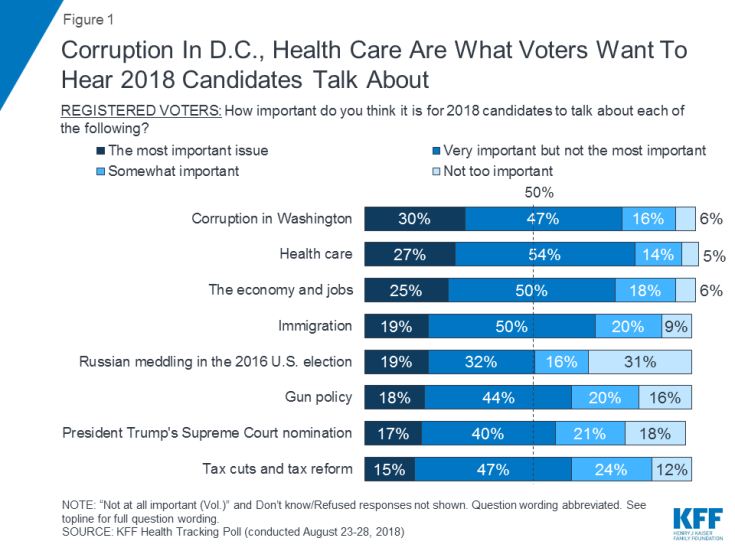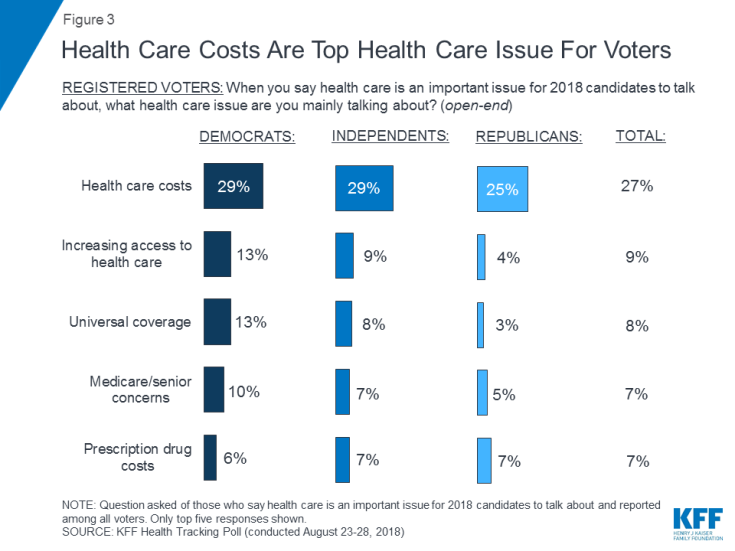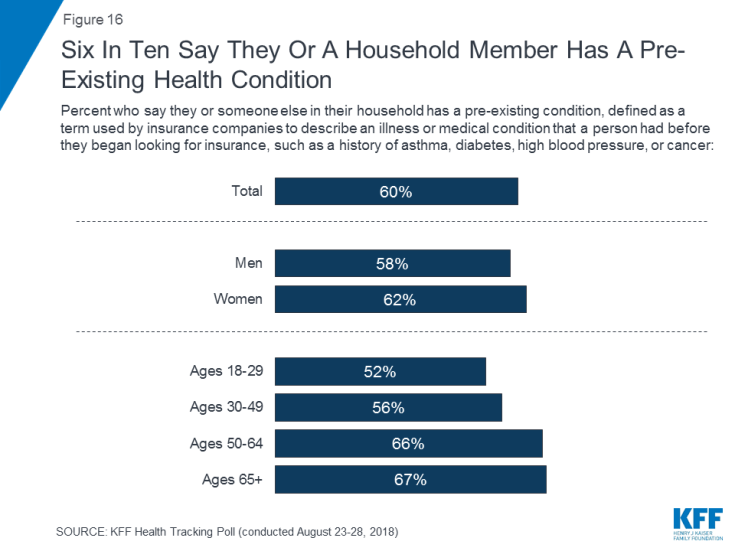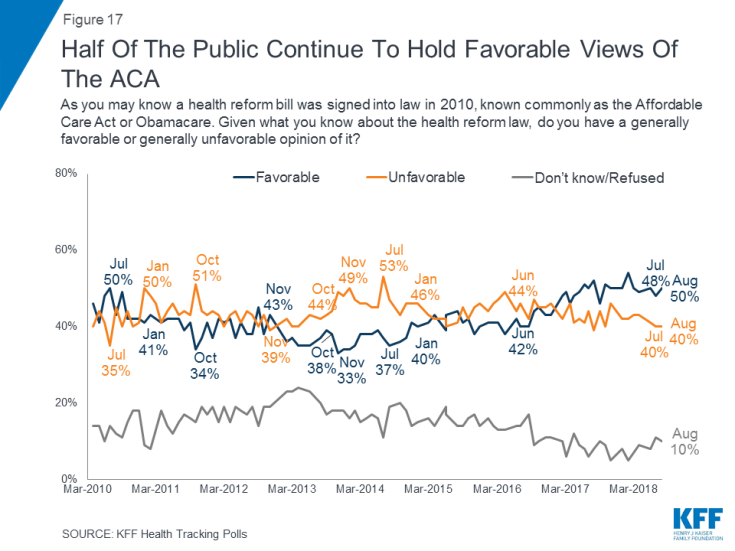Kaiser Health Tracking Poll – Late Summer 2018: The Election, Pre-Existing Conditions, and Surprises on Medical Bills
Key Findings:
- The latest Kaiser Health Tracking Poll finds recent political events weighing heavy on the minds of voters when it comes to the 2018 midterm elections. Three in ten voters (33 percent of independent voters, 32 percent of Democratic voters, and 25 percent of Republican voters) say corruption in Washington is the “most important” topic for 2018 candidates to discuss. This is the first time corruption in D.C. was included in KFF’s list of possible campaign topics and, along with health care (27 percent) and the economy and jobs (25 percent), it is among the top topics for voters three months before the 2018 midterm election.
- KFF polling continues to find pre-existing conditions as a widespread concern and with the impending lawsuit Texas v. United States, a majority of the public say it is “very important” that the Affordable Care Act’s (ACA) protections for people with pre-existing conditions ensuring guaranteed coverage (75 percent) and community rating (72 percent) remain law. About half (52 percent) of the public are “very worried” that they or someone in their family will have to pay more for health insurance and four in ten (41 percent) are “very worried” they will lose their coverage if the Supreme Court overturns these protections.
- Over the past few months President Trump has maintained a tense relationship with drug companies over the price of prescription drugs. This month’s tracking poll finds an increase in the share of the public who say drug companies making too much profit is a “major reason” why people’s health care costs have been rising (78 percent compared to 62 percent in 2014). However, less than half of the public – four in ten (42 percent) – say they think President Trump’s strategy of publicly shaming drug companies and asking them to cut prices will be effective in reducing prescription drug costs overall and a similar share (38 percent) are confident that the president will be able to deliver on his promise that Americans will pay less for prescription drugs under his administration.
- Health care costs continue to be an important issue in the 2018 midterm election and beyond. When given a list of possible worries, unexpected medical bills tops the list that includes other health care costs such as premiums, deductibles and even drug costs, as well as other household expenses. Four in ten insured adults ages 18-64 say there has been a time in the past 12 months when they received an unexpected medical bill and one in ten say they received a “surprise” medical bill from an out-of-network provider in the past year.
The 2018 Midterm Election
With the 2018 midterm election in full swing, the latest Kaiser Health Tracking Poll finds corruption in Washington emerging as one of the top topics voters want to hear candidates talk about during their campaigns. Fielded in the days after the indictment of Michael Cohen and jury decision in the Paul Manafort trial, three in ten voters (30 percent) – including about one-third of independent voters and Democratic voters, and one-fourth of Republican voters – say corruption in Washington, D.C. is the most important topic for 2018 candidates to talk about during their campaigns. This ranks among the top topics, which also includes health care (27 percent) and economy and jobs (25 percent).
About one-fifth of voters say various other topics including immigration (19 percent), the investigation of whether Russian meddled in the 2016 U.S. presidential election (19 percent), and gun policy (18 percent) are the most important issues for the 2018 campaigns. Similar shares also say it is most important for candidates to talk about President Trump’s nomination of Brett Kavanaugh to the U.S. Supreme Court (17 percent) and tax cuts and tax reform (15 percent).
Health Care Continues to Be Top topic for Democratic Voters
As reported in previous KFF Tracking Polls during the 2018 election season, health care remains a top topic for Democratic voters (34 percent) along with corruption in D.C. (32 percent) and the investigation into Russian meddling in the U.S. election (29 percent). A larger share of independent voters want to hear the candidates discuss corruption (33 percent) than any other topic except health care (26 percent), while similar shares of Republican voters want to hear candidates talk about the economy and jobs (31 percent), immigration (27 percent), and corruption in D.C. (25 percent).
| Table 1: Top Topics for 2018 Campaigns Vary by Partisanship | |||
| Percent who say each of the following is the most important topic for the 2018 candidates to talk about: | Democratic voters | Independent voters | Republican voters |
| Corruption in Washington | 32% | 33% | 25% |
| Health care | 34 | 26 | 20 |
| The economy and jobs | 21 | 24 | 31 |
| Immigration | 18 | 15 | 27 |
| Investigation into whether Russia meddled in the 2016 U.S. election | 29 | 20 | 6 |
| Gun policy | 24 | 15 | 14 |
| President Trump’s Supreme Court nomination | 18 | 17 | 19 |
| Tax cuts and tax reform | 16 | 14 | 18 |
Battleground Voters
Corruption in Washington D.C. (32 percent), the economy and jobs (27 percent), and health care (26 percent) are the top topics among voters living in areas where there are competitive House, Senate, or Governor races. Voters in areas with competitive elections – similar to voters, generally – are less likely to prioritize candidates talking about immigration (17 percent), Russian meddling in the U.S. election (17 percent), tax cuts and tax reform (16 percent), President Trump’s Supreme Court nomination (15 percent), and gun policy (14 percent).
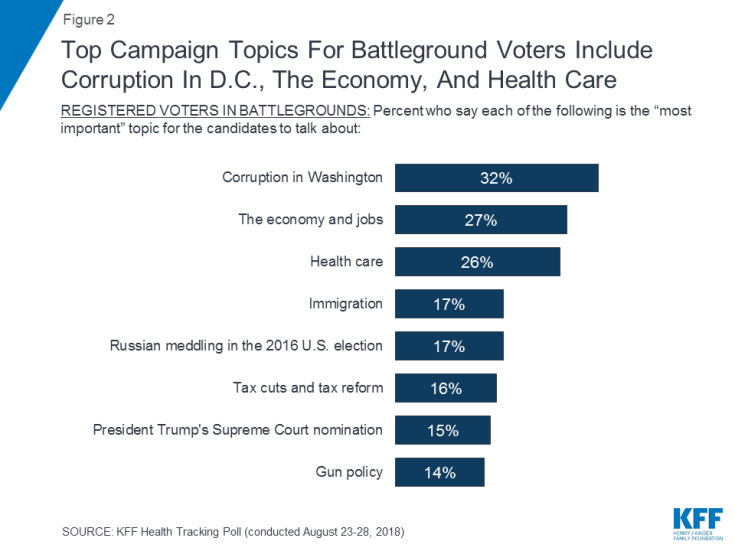
Figure 2: Top Campaign Topics For Battleground Voters Include Corruption In D.C., The Economy, And Health Care
2018 Midterm Election Analysis
As part of Kaiser Family Foundation’s effort to examine the role of health care in the 2018 midterm elections, throughout the year we will be tracking the views of voters – paying special attention to those living in states or congressional districts in which both parties have a viable path to win the election. This group, referred to in our analysis as “voters in battlegrounds” is defined by the 2018 Senate, House, and Governor ratings provided by The Cook Political Report. Congressional and Governor races categorized as “toss-up” were included in this group. A complete list of the states and congressional districts included in the comparison group is available in Appendix A.
Health Care Costs Remain Top Health Care Issue for 2018 Campaigns
When voters who want to hear candidates talk about health care are asked what health care issue they most want to hear the candidates discuss, about one-third (27 percent of all voters) mention health care costs. Health care costs are mentioned three times more often than any other health care issue such as increasing access to health care (9 percent of all voters), universal coverage (8 percent of all voters), Medicare or senior concerns (7 percent), or prescription drug costs (7 percent). Health care costs are also the top health care issue mentioned by Democratic voters (29 percent), independent voters (29 percent), and Republican voters (25 percent).
The Public and Health Care Costs
With health care costs reigning as the top health care issue in the 2018 midterm election, this month’s poll looks at the public’s perceptions of and experiences with health care costs and finds Democrats, independents, and Republicans less polarized on the issue of health care costs than other health care issues.
Overall, nearly nine in ten (89 percent) Americans say they are concerned about the increases in the amount individuals pay for health care, with about six in ten saying they are “very concerned.” A larger share of the public say they are “very concerned” about increases in the amount individuals pay than say the same about increases in what the nation as a whole spends on health care (49 percent). Four in ten (41 percent) of the public are “very concerned” about increases in spending on government health insurance programs like Medicare and Medicaid while fewer – about three in ten – are “very concerned” about increases in the amount employers pay for employees’ health care.
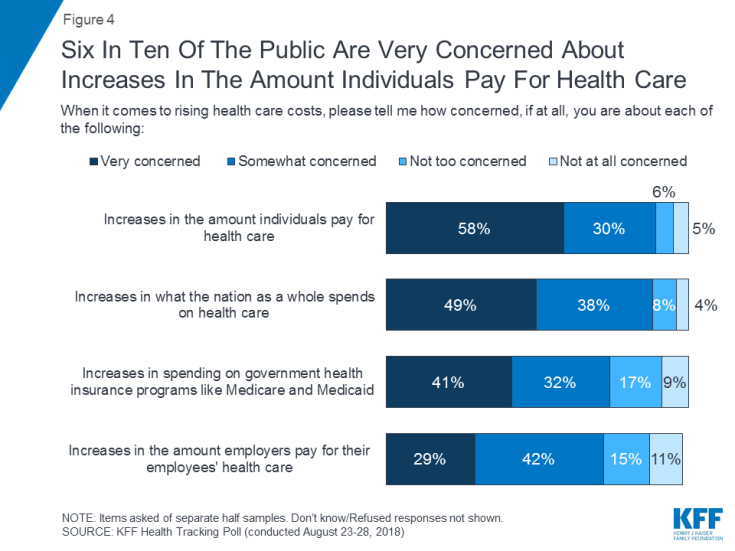
Figure 4: Six In Ten Of The Public Are Very Concerned About Increases In The Amount Individuals Pay For Health Care
There are no differences by partisanship with similar shares of Democrats, independents, and Republicans reporting being concerned about the increases in the amount individuals pay for health care costs.
Who Does the Public Blame For Rising Costs?
When asked about the reasons behind rising health care costs, the public finds plenty of sources to blame and an increasing share of the public blames prescription drug companies. Eight in ten (78 percent) say drug companies making too much money is a “major reason” why people’s health care costs have been rising, which is up from 62 percent in 2014.
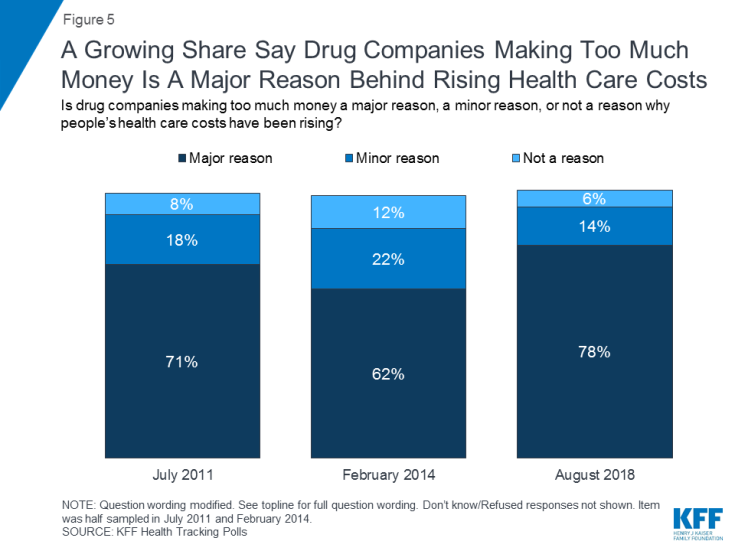
Figure 5: A Growing Share Say Drug Companies Making Too Much Money Is A Major Reason Behind Rising Health Care Costs
Joining drug companies’ profits at the top of the list are fraud and waste in the health care system (71 percent), hospitals charging too much (71 percent), and insurance companies making too much money (70 percent). About six in ten also say a “major reason” why people’s health care costs have been rising is because new drugs, treatments, and medical technologies are often very expensive.
Fewer, but still about half, say doctors charging too much (49 percent), an aging population (47 percent), and the cost of medical malpractice lawsuits (45 percent) are “major reasons” for rising costs. Less than half of the public blame health care consumers or political actions: people getting more services than they really need (41 percent), the 2010 ACA (39 percent), the Trump Administration’s recent actions on health care (38 percent), or people not shopping for lower-priced doctors and services (28 percent).
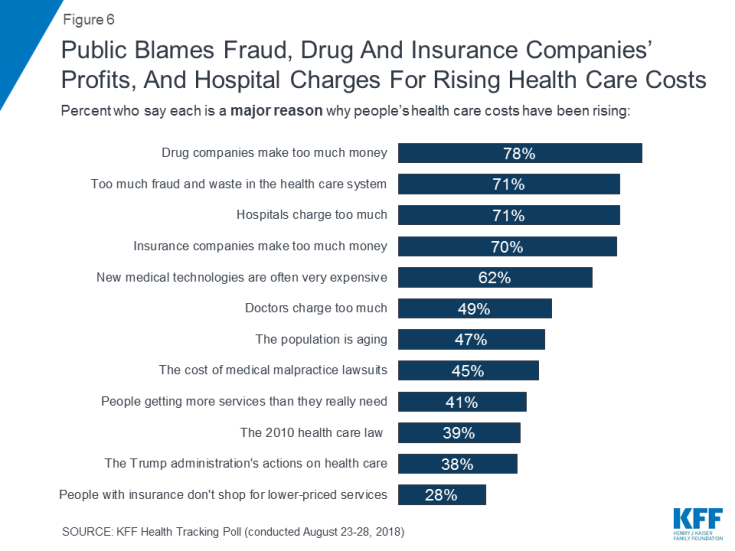
Figure 6: Public Blames Fraud, Drug And Insurance Companies’ Profits, And Hospital Charges For Rising Health Care Costs
The ranking of the top reasons behind rising health care costs doesn’t vary across party identification but a larger share of Republicans place blame on the 2010 health care law (69 percent) and a larger share of Democrats say the Trump administration’s recent actions are a “major reason” (59 percent) for rising costs.
Unexpected Medical Bills
One component of health care costs are unexpected medical bills. Two-thirds of Americans say they are either “very worried” (38 percent) or “somewhat worried” (29 percent) about being able to afford their own or a family member’s unexpected medical bills. When given a list of possible problems, unexpected medical bills tops the list that includes other health care costs as well as other household expenses. Three health care costs are included in the top five worries among Americans, with half of insured adults saying they worry about being able to afford their health insurance deductible (53 percent) and more than four in ten adults worrying about affording prescription drug costs (44 percent).
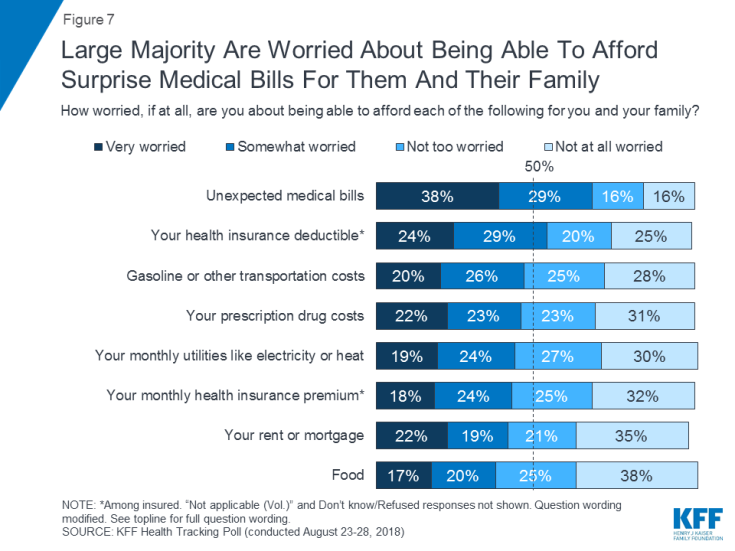
Figure 7: Large Majority Are Worried About Being Able To Afford Surprise Medical Bills For Them And Their Family
One type of unexpected medical bill is a “surprise bill” for out-of-network care, when a patient receives care from a health care provider who is not part of their insurance network. This can occur either when a patient receives care from a hospital outside of their network or an out-of-network doctor who provides care at an in-network facility. Four in ten (39 percent) insured adults ages 18-64 say there has been a time in the past 12 months when they received care from a doctor, hospital, or lab that they thought was covered and their health plan either didn’t cover the bill at all or covered less than they expected. For many of these (one in ten insured adults, 18-64, overall), this surprise bill was related to care received from an out-of-network provider.

Figure 8: Four In Ten Insured Adults, 18-64, Say They Had Unexpected Medical Bill, One In Ten Had Surprise Out-Of-Network Bill
Half of those who had an unexpected medical bill (39 percent of insured adults, 18-64) say the amount they were expected to pay was less than $500 overall while 13 percent say the unexpected costs were $2000 or more.
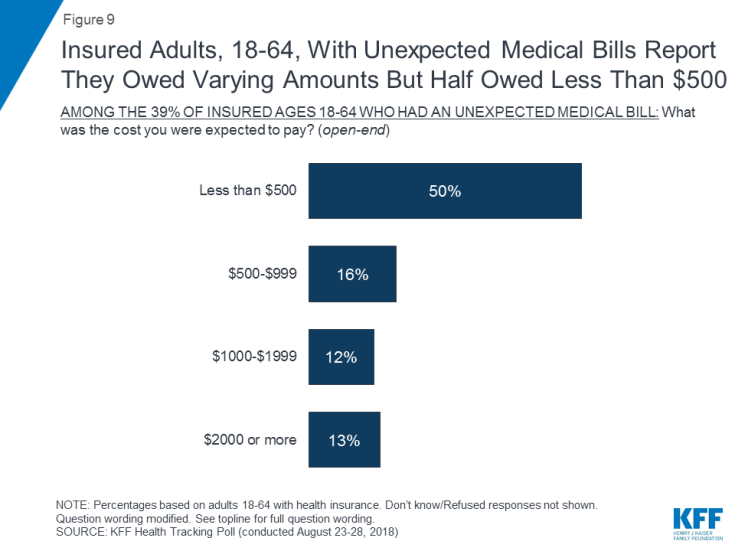
Figure 9: Insured Adults, 18-64, With Unexpected Medical Bills Report They Owed Varying Amounts But Half Owed Less Than $500
The Trump Administration and Health Care
This month’s tracking poll also examines the public’s reaction to two areas of health care where there has been recent action by the Trump administration: prescription drug prices and continued protections for people with pre-existing conditions.
President Trump and Prescription Drug Prices
President Trump has recently criticized several prescription drug companies and publicly called on them to lower the cost of their prescription drugs.1 A majority of the public (55 percent) say President Trump’s strategy of publicly calling on drug companies to lower their costs will either be “not too effective” or “not at all effective” in reducing the cost of prescription drugs overall, while four in ten (42 percent) say it will be effective (either “very” or “somewhat”).
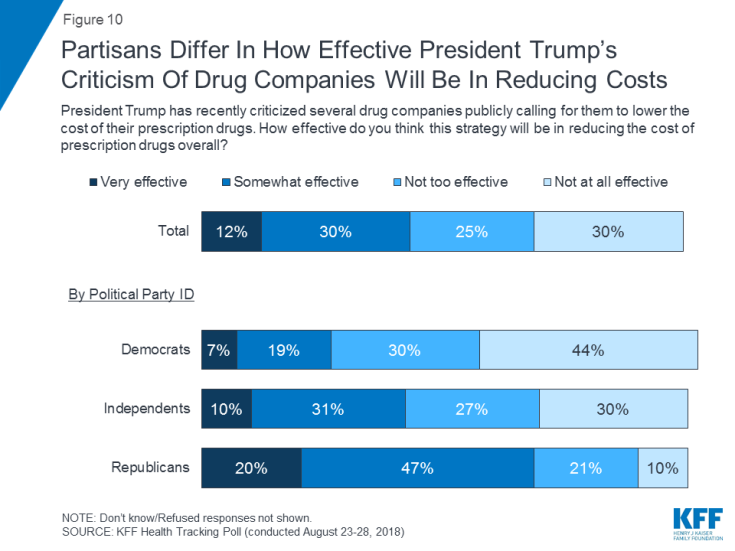
Figure 10: Partisans Differ In How Effective President Trump’s Criticism Of Drug Companies Will Be In Reducing Costs
There are large partisan differences with three-fourths (74 percent) of Democrats saying this strategy will not be effective while two-thirds of Republicans say it will be effective. A larger share of independents say it will not be effective than will be effective (57 percent v. 41 percent).
In addition, four in ten (38 percent) say there are either “very confident” or “somewhat confident” President Trump and his administration will be able to deliver on his promise that Americans will pay less for prescription drugs than they pay now. This number remains virtually unchanged since March 2018, which was prior to President Trump releasing his plan titled “American Patients First,” aimed at lowering the price of prescription drugs.
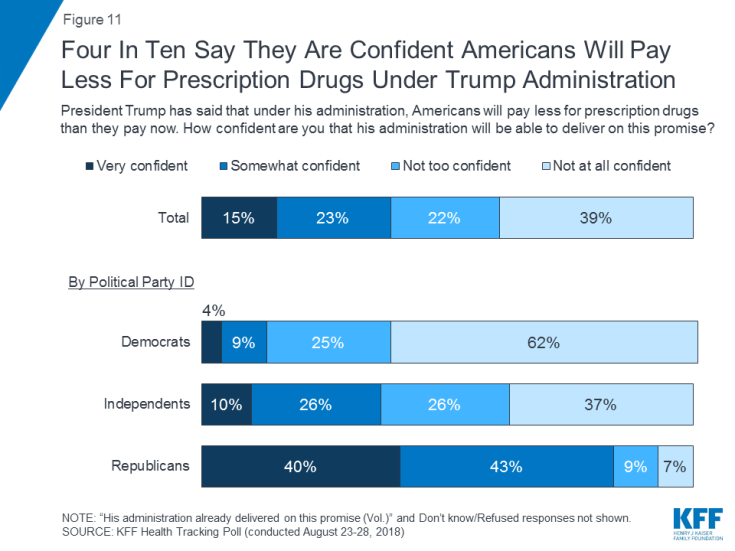
Figure 11: Four In Ten Say They Are Confident Americans Will Pay Less For Prescription Drugs Under Trump Administration
The Trump Administration and Pre-Existing Conditions
In June 2018, President Trump’s administration announced – as part of a lawsuit known as Texas v. United States, brought by 20 Republican state attorneys general – it will no longer defend the ACA’s protections for people with pre-existing medical conditions. These provisions prohibit insurance companies from denying coverage based on a person’s medical history (known as guaranteed issue), and prohibit insurance companies from charging those with pre-existing conditions more for coverage (known as community rating). Texas v. United States will decide, among other things, whether both of these protections are unconstitutional and if they will be deemed invalid once the individual mandate penalty goes away starting January 1, 2019.
The majority of the public say it is “very important” to them that the ACA’s provisions protecting those with pre-existing conditions remain law. Three-fourths of the public say it is “very important” to them that the provision that prohibits health insurance companies from denying coverage because of a person’s medical history remains law. An additional fifteen percent say it is “somewhat important” this provision remains law. Similarly, about seven in ten say it is “very important” that the provision that prohibits health insurance companies from charging sick people more remains law, while an additional one in five (19 percent) say it is “somewhat important.”

Figure 12: Majorities Say It Is Very Important That ACA Provisions Protecting Those With Pre-Existing Conditions Remain Law
Majorities Across PArty Lines Support Protections for Those With Pre-eXisting Conditions
Majorities, across party identification and household health status, say it is “very important” that these protections remain law. Nine in ten Democrats (86 percent), three-fourths of independents, and 58 percent of Republicans say it is “very important” that insurance companies cannot deny coverage because of a person’s medical history. Similarly, a majority (88 percent of Democrats, 71 percent of independents, and 56 percent of Republicans) say it is “very important” that health insurance companies cannot charge sick people more. Even among those living in households without anyone with pre-existing conditions – therefore, unlikely to be affected negatively by this change in policy – a majority say it is “very important” these protections remain.
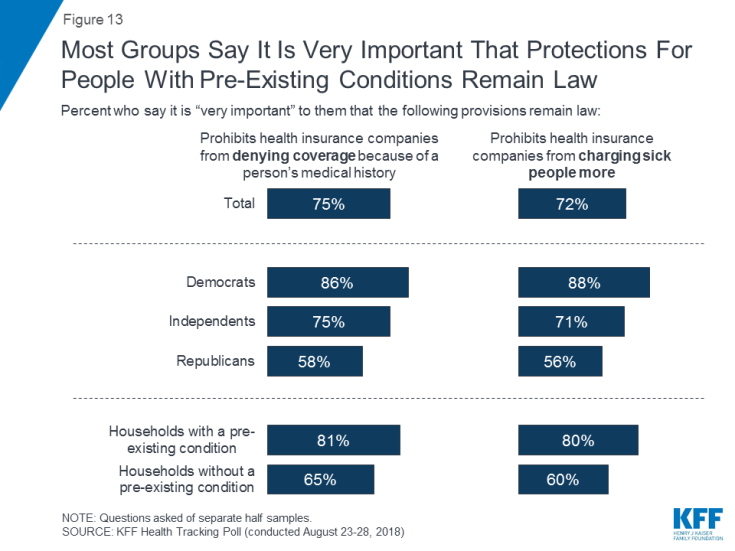
Figure 13: Most Groups Say It Is Very Important That Protections For People With Pre-Existing Conditions Remain Law
Majorities Worry about losing coverage or having to pay more if protections are taken away
A KFF analysis estimates that 27 percent of adults ages 18-64 have a pre-existing condition that would have led to a denial of insurance in the individual market prior to the implementation of the ACA. This month’s tracking poll finds four in ten (41 percent) of the public are “very worried” that they or a family member will lose coverage if the Supreme Court overturns the ACA’s pre-existing condition protections. In addition, half (52 percent) are “very worried” they or a family member will have to pay more for health insurance coverage.

Figure 14: Large Shares Are Worried About Paying More For Or Losing Coverage If Protections Are Overturned
Majorities – across gender and age groups – report being worried that they or someone in their family will either lose health insurance coverage or have to pay more for their coverage if the Supreme Court overturns the health care law’s protections for people with pre-existing health conditions. As expected, people living in households with someone with a pre-existing condition are more likely to report being “very worried” or “somewhat worried” about losing coverage or having to pay more.
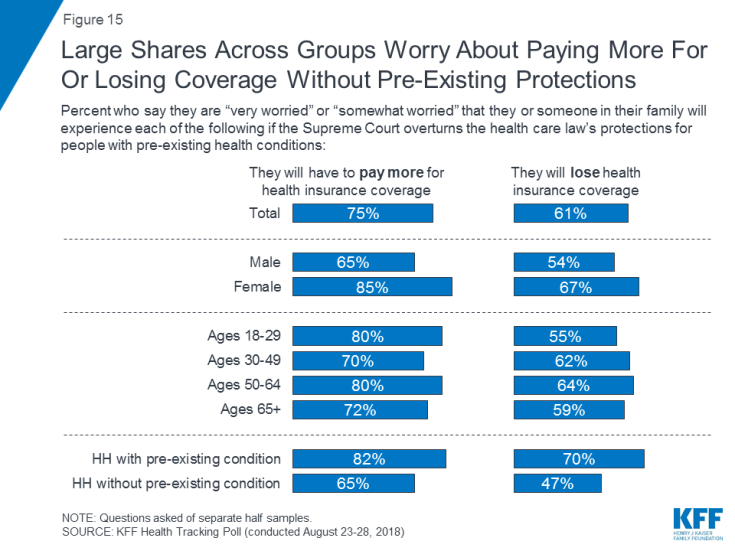
Figure 15: Large Shares Across Groups Worry About Paying More For Or Losing Coverage Without Pre-Existing Protections
The survey also finds six in ten of the public saying they or someone in their household suffers from a pre-existing medical condition such as asthma, diabetes, or high blood pressure. 2 Older adults are more likely to report someone in their household with a pre-existing condition than younger adults.
The Affordable Care Act
This month marks the 90th time KFF has asked the public’s perception of the 2010 Affordable Care Act on a poll since April 2010. This month, half of the public holds a favorable view of the Affordable Care Act while four in ten hold an unfavorable view. Similar shares of Republicans hold unfavorable views of the 2010 law (78 percent) as Democrats hold favorable views (77 percent). Half of independents say they hold favorable views toward the ACA, while 39 percent hold unfavorable views.

